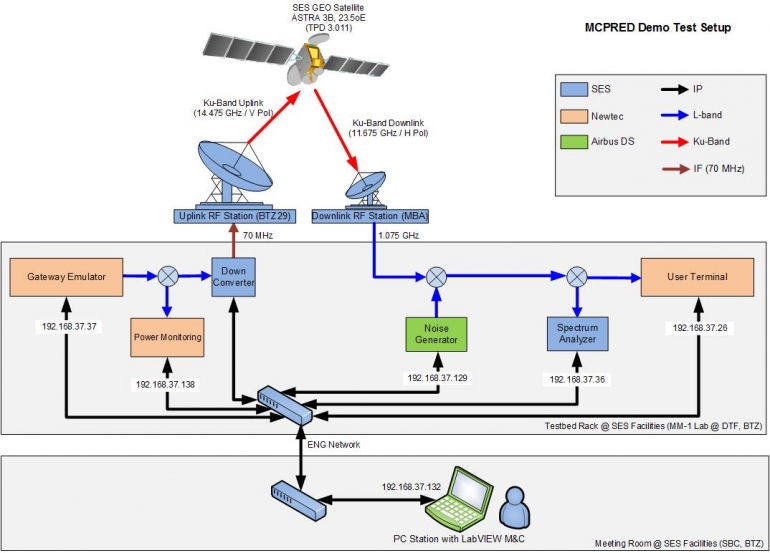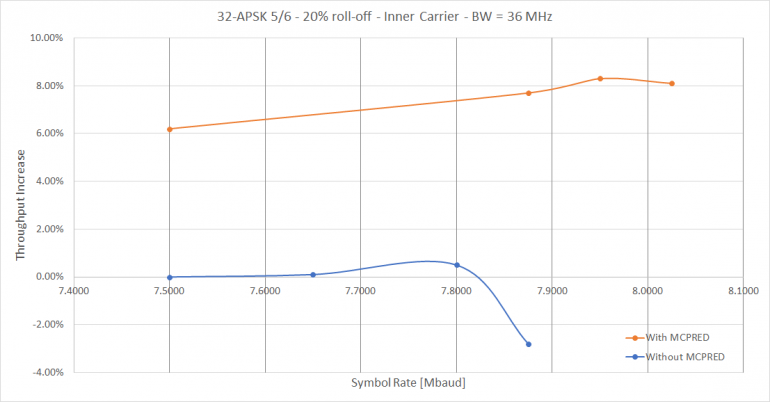New On-ground Technology Boosts Link Margin
A powerful consortium consisting of Airbus, Newtec, SES and the University of Luxembourg has demonstrated a new technology that can deliver an improvement of 9 per cent in Satcom data transmission rates within a given bandwidth.
Supported through an Advanced Technology project within the ARTES programme, the consortium set out to improve Satcom link margins by developing and demonstrating a novel, on-ground technology for multi-carrier digital “predistortion”. The starting point was a state-of-the-art technique that previously existed only in literature.
Based on this theoretical technique and by changing some key digital processing algorithms, aimed at iterative, inter-modulation interference cancellation at the transmitter side, the team improved the link margin. Computer simulations indicated a link margin improvement in the order of 1 dB for linearized Travelling Wave Tube Amplifiers (TWTA), which was used for the reference High Power Amplifier model because most satellite transponders today are shipped with these kinds of amplifiers. (For the sake of completeness, it shall be noted that a greater improvement of 3dB was achieved with non-linearized TWTA.)
In keeping with the purpose of ARTES, the project aimed not only to achieve theoretical advances, but also to reach higher Technology Readiness Levels through practical demonstration. Accordingly, the project team validated the prototype on a laboratory test-bench and followed up through practical application on a real satellite end-to-end transponder link at Ku-band.
These field measurements demonstrated a link margin improvement of 0.8 dB with 4 carrier transmission (4 x 7.5 Mbaud DVB-S2 carriers in 36 MHz). From a commercial perspective, this translates to an improvement in data transmission rate of about 9 per cent, compared to a link using the same bandwidth but without the new technology. This has been possible because the increased robustness achieved by the iterative multi-carrier digital predistortion has been exploited to allow carriers overlapping, thus to get higher symbol rates (e.g., 8.2 Mbaud).
A hallmark of ARTES is its focus on developing services and products for which there is a definite market need or opportunity, as evidenced by the involvement of commercial industry partners in the projects concerned. In this case, Newtec led the project as the ground segment manufacturer; Airbus acted as space segment integrator; and SES provided the satellite for the field trial.
Dieter Duyck, Ph.D., Director Patents and Innovation from Newtec said: “The developed multicarrier predistortion technology realized proven, certain and unexpected gains over even linearized transponders and brings multicarrier transmission, despite common beliefs, in the same efficiency champions league as single carrier transmission, opening up a whole new range of opportunities such as dynamic bandwidth and power allocation to multiple beams without efficiency loss”
Although the next steps naturally relate to commercial implementation, it can be revealed that this technology has now been upgraded to “wideband” operations (up to a 250 MHz transponder) in the context of another ARTES project called ECO, led by Avanti and also involving Newtec.
Omar Iqbal, CTO Advisor and Satellite Technology Projects from Avanti said: “We are pleased to support demonstration of Newtec’s wide-band multi-carrier predistortion technology on our new High Throughput Satellite, HYLAS 4. The spacecraft provides Ka-band services through 64 spot beams across all of Sub-Saharan Africa and Europe. Additionally, HYLAS 4 has four steerable beams that can be used to provide additional capacity. The successful demonstration paves the way for operational introduction of MCPD in 2019, underlining Avanti’s commitment to innovate with our technology partners in order to offer our customers improved throughputs and reduced costs.”




